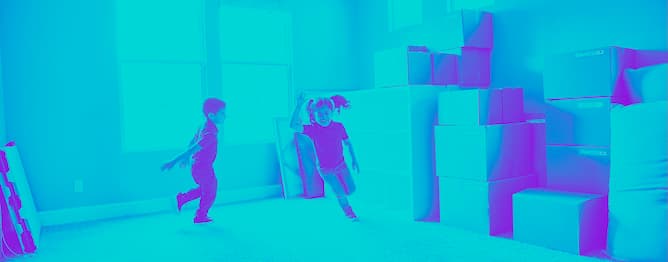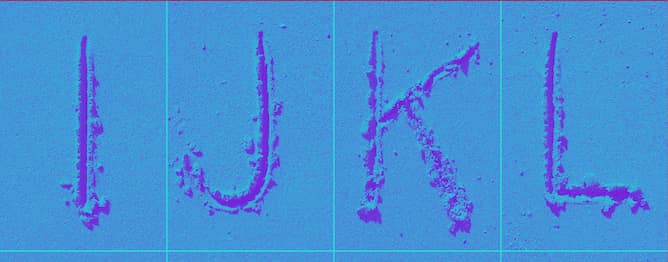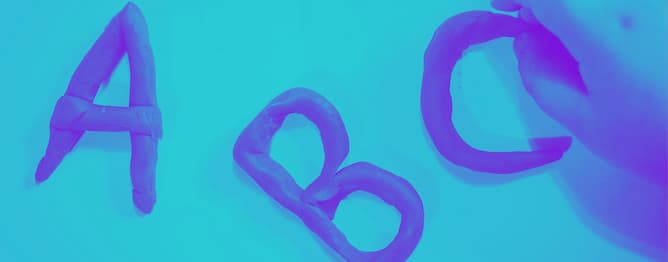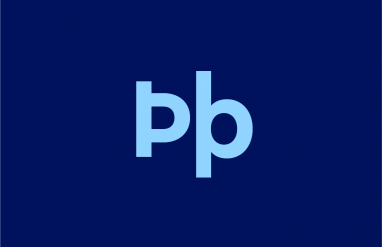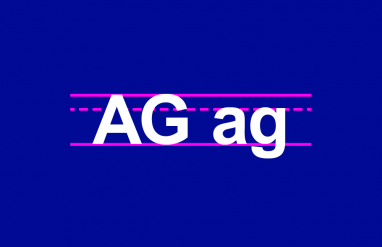By Lindsay Barrett
Parents, caregivers, and educators celebrate children’s mastery of the ABCs as an important milestone on the road to reading and writing. But, there’s much more to learning the alphabet than a cute rendition of the ABC song.
Here’s the lowdown on the different aspects of learning about letters—and plenty of fun activities to help your children or students become alphabet experts.
How kids first learn about letters and sounds
Many children begin learning their letters by singing the alphabet song—complete with that adorable “Elemeno P” for L, M, N, O, P—before they even know anything about what letters are.
Young children also begin learning about sounds in language well before they know about letters. Through hearing and producing speech sounds, children begin to intuit that words are made up of little units of sound, and these different sounds are what distinguish words. Even toddlers can recognize that a request to find one’s socks isn’t the same as one to find rocks, though they likely can’t articulate how they know.
Phonics vs. phonetics vs. phonemes
Individual units of sound are called phonemes. The ability to hear and manipulate these sounds is known as phonemic awareness. While phonemic awareness refers to speech sounds, it is an essential building block for learning to read and write using an alphabet. It’s only when we can hear individual sounds in words that we can write them or use them to read.
Sound and letter knowledge do eventually merge for kids. Through both informal exposure and direct teaching, kids learn to recognize and write each letter symbol in the alphabet in both uppercase and lowercase. As they do this, they also must develop an understanding of the alphabetic principle—that an alphabet is made up of written symbols that correspond to spoken sounds.
Phonics is a method of teaching reading and spelling based upon the phonetic interpretation of ordinary spelling. The very beginning of phonics instruction includes learning the sounds that the letters of the alphabet represent. Phonetics is the science or study of speech sounds and their production, transmission, and reception, and their analysis, classification, and transcription.
Does this feel overwhelming? Don’t worry. Luckily, we only need to learn to read and write once! Below are some fun and engaging activities to help your child learn letters! And below the activities there are answers to some common questions about how and why children should learn letters.
Letter recognition and sound activities
It might sound silly, but it’s helpful for adults to brush up on the basics to avoid giving kids misinformation before you start these activities. Take a few minutes to confirm that you know the correct sound for each letter. (This quick video by kid-favorite YouTube personality Jack Hartmann covers this nicely.) Notice how our buddy Jack does not add an extra schwa (“uh”) sound when enunciating the sound each letter makes. F is a quick /f/, not “fuh,” L has s a clipped /l/ sound, not a sing-song “laa,” and so on.
Pay special attention to the short vowel sounds of A, E, I, O, and U. These are easily bungled, but kids need a solid grasp on them when they start trying to read words like mat, dip, and bug by saying each sound and blending them together.
Learning letter sounds accurately gives kids a leg up when they start blending sounds together to read words. It’s a lot easier to blend the short, enunciated sounds /h/ /u/ /m/ than the mouthful of “huh” “uhhhhh” “muh.” (Trust us. Try both versions out loud; you’ll see what we mean.)
Alphabet soup
Put magnetic letters, letter puzzle pieces, or foam letters into a big bowl. Give your child a big spoon and stir the metaphorical pot of alphabet soup. Scoop out a letter and say its name and/or sound.
Letter treasure hunt
Hide magnetic letters in a tray of wet sand, Kinetic Sand, Play-Doh, or other similar material. Have a child hunt for the letters, identifying each one as they discover it. You could use letters that spell a common word or the child’s name and make it a challenge to find them all.
Object match
Gather up a collection of household items that begin with different letter sounds. Ask children to match objects to cards with their beginning letters. Prioritize clear examples of a letter’s most common sound, as described in the discussion of keywords above. Think key, sock, potato, and olives over knife, shovel, phone, and orange.
Object sort
Extend the object match game by collecting groups of items that begin with the same letter. Have children sort items by beginning letter. For example, sort the words dog, dinosaur, domino, dice, diaper, doll, and donut into a D pile, and magnet, mouse, muffin, motorcycle, marble, and mirror into an M pile.
Letter hunt
Ask children to hunt for one or two specific letters around the house or neighborhood. Book covers, mail, product packaging, and signs are all good places to look. You will get bonus points if you relinquish your phone for children to photograph the letters they find and create a picture collage.
Personalized ABC book
Photograph items and people around your home or neighborhood to create a personalized digital or printed ABC book. Fill in drawings or images found online for any letters you can’t cover. Familiar faces and items will make letter learning more memorable for kids.
Letter collage
Give kids a stack of magazines or newspapers and have them cut out letters to make a collage. Have them hunt for a specific letter or make the whole alphabet fair game. You could also pre-cut a pile of letters for younger kids. This activity is especially great for helping kids recognize that an A is still an A, for instance, no matter its size or font.
KABOOM! Game
This classroom favorite is worth the five minutes it takes to make. Write each letter on the end of a popsicle stick. Also make one or two sticks that say “KABOOM!” To play, set a timer, and take turns drawing a stick out of a container. If a player can say the letter name correctly, they get to keep it. But, if they draw KABOOM, they have to put all their sticks back. The player with the most sticks when the time is up wins. Vary the game by saying the letter sound or a word that starts with that letter. Repeat endlessly; the anticipation never gets old.
Letter swat
This is one of kids’ top picks. Write letters on sticky notes and spread them out in a safe area on the floor or wall. Give kids plastic fly swatters and call out letters for them to swat.
Name puzzles
Write the letters in a child’s name on cardstock. Cut each letter apart. Using a card with his or her name as a reference—or later, working from memory—ask your child to reassemble his or her name, saying each letter in order. You can create both uppercase and lowercase versions of letters for this activity.
Alphabet four-corner tag
Mark each corner area of a safe indoor space with a different letter, or mark and label a play space outdoors with chalk or cones. Call out a letter name, sound, or a word starting with that letter. Players must run to the correct corner before the caller tags them.
Uppercase and lowercase match
Write the uppercase and lowercase forms for each letter on an index card. Chop each card in half, making 26 matching sets. Have children match each uppercase letter with its lowercase version, or use the pairs to play Memory or Go Fish. Start with a smaller set of matching pairs if the entire alphabet is overwhelming.
Letter formation activities
Sky writing
Write a letter on a large dry-erase board, easel, or on a foggy window. Have your child grab a toy airplane and “fly” it to trace the shape of the letter from afar with an outstretched arm while making appropriate “zoom” or “whoosh” sounds for each stroke. Using large muscle movements to make letter shapes can help children remember letter forms.
Mystery letters
Draw a letter on a child’s back with your finger for him or her to guess. Talk through the features of the letter for clues. For instance, say, “I’m making a big line down. Now I’m making three little lines over, over, and over” for the letter E. Then swap roles.
Letters in the dirt
Get back to basics! Grab a pointy stick and practice writing letters on the ground.
Nature letters
Use items found outdoors—sticks, rocks, leaves, flowers, acorns, or shells— to make letter shapes. For extra credit, photograph each shape and create a unique ABC book or wall display.
Make letters with small objects
Write a letter on a dry-erase board or sheet of paper and give children a collection of small, flat items that won’t roll away, like buttons, pennies, LEGO pieces, or bingo chips. Show children how to place items along the letter lines, moving in the same direction as if they were writing the letter.
Water-painting letters
Have children “paint” letters using a paintbrush dipped in water on flat rocks, pavers, or another outdoor surface. When the letters dry and disappear, repeat. Bonus: this simple activity is also very soothing!
Dough letters
Use Play-Doh or mix up some homemade bread or pretzel dough. Show kids how to roll dough into snakes, and then how to use make snakes into letters.
Household labeling
Give a child a stack of Sticky Notes and ask them to label items around the room with the letter that starts the name of that item. Strategically suggest items that have a distinct, keyword-beginning sound, like T for table, L for light, R for rug, B for book, D for door, etc.
Should kids learn letter symbols and sounds in a certain order?
Alphabet-themed activities like songs, puzzles, books, and games involve the entire alphabet. General exposure is great for kids, but learning all 26 letters of the English alphabet and their corresponding sounds can take a while, especially without the crutch of alphabetical order. Kids don’t have to know the whole alphabet to begin developing early understandings about how reading and writing work, but having a letter-learning strategy can be helpful.
Often, the letter symbols that preschool kids learn to identify first are the ones that start their names. Researchers sometimes call this the own-name effect. Hands down, “D is for Darius” or “F is for Fiona” has the most meaning for a self-focused kiddo. “M for Mommy” or “D for Daddy,” as well as the first letters of siblings’ or other special peoples’ names are logical candidates for subsequent headlining letters. Young kiddos often start to recognize the letters in high-frequency words like LOVE, or print they encounter in everyday life (called environmental print), such as in snack packaging or signs they see often, too.
When homing in on one letter at a time for direct teaching about sound-symbol correspondence, familiarity and utility trump alphabetical order. High-quality elementary phonics curricula approach teaching letters and sounds in, as many educators refer it, an explicit and systematic way; they give straightforward explanations instead of having kids guess, and they move forward in an intentional sequence, usually teaching high-use consonants like T, B, F, N and M first. When kids know a few consonant sounds and a short vowel sound such as A, they can begin to spell and read words, like tab, bat, and fan.
Using words as reminders about letter sounds
When thinking about letter sounds, it’s a huge help for kids to associate a word with each letter that correctly conveys its sound. Many literacy programs call these associated words keywords. Cat is a better keyword for the /c/ sound most commonly made by the letter C than cheetah, which starts with the /ch/ sound. Also check a word for familiarity. Q for quetzal fits well with an animal theme, but isn’t as likely to resonate with kids as queen or quiet.
You don’t need to throw out alphabet books or sets of alphabet cards that use less-than-ideal keywords, though. Just call kids’ attention to examples that might be confusing and tack on more straightforward ones.
How to effectively teach handwriting
Blaming your own chicken scratch penmanship is no excuse here. Refresh your memory on the correct formations of letters before trying to teach a kid to write them. If a child uses a specific handwriting curriculum at school, use the same terms outside of school. Most programs refer to the components of letters with certain vocabulary (e.g., “big lines,” “little lines,” and so forth) and give catchy prompts for forming each letter. It’s extremely helpful for teachers to provide families a cheat sheet with the prompts their handwriting program uses for forming each letter to reference at home.
Rather than drawing letters as an artistic endeavor, the goal is for kids to write letters the same way every time, starting at the top and using consistent strokes. So, there’s no need to go rogue—just say the same thing over and over! If you don’t have access to handwriting curriculum resources through school, the Learning Without Tears program is a reliable one to check out.
Writing letters can be hard work in the beginning. Setting the pencil aside and doing activities that ask kids to build letter shapes is invaluable, especially in preschool. Many of the activities below are great for this.
Learning the alphabet is a rite of passage in kids’ literacy journey. Be consistent in your messaging about letter shapes and sounds and offer tons opportunities for repetition. Letter by letter, they’ll get there. Need even more activity ideas? Many of these sight word practice activities are easily adaptable to practicing individual letters.
Lindsay Barrett is a teacher and literacy consultant. She writes resources for educators and parents. Find out more about her work at lindsay-barrett.com.




